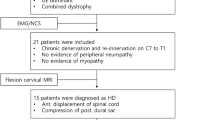Summary
Twenty-seven in-patients with hemiplegia following brain injury were studied by using upper extremity median nerve somatosensory evoked patentials (SVEP), Brunnstrom assessment in hemiplegic hand and assessment of the patients' activities of daily lioing (ADL) (Barthel index). The upper extremity median nerve SEP on the affected and normal sides was determined. By using Kovindha standard, upper extremity median nerve SEP was graded in accordance with N20. The correlation between the differences of SEP N20 amplitude and the latencies on the both sides and the Barthel index scores was analyzed. A Spearman correlation analysis was made between the median nerve SEP N20 grades and Brunnstrom stages in hand or ADL on the affected side. The results showed that upper extremity median nerve SEP grades were positively correlated with those of the Brunnstrom stages in hand (r i=0.6925,P 1<0.01). The correlation coefficient between SEP N20 grades and patients' ADL grades wasr 2=0.5015,P 2<0.01. It was concluded that upper extremity median nerve SEP could be used as a sensitive electrophysiological predictor to clinically assess hemiplegic hand function. SEP N20 might play a role in predicting the ADL of the patients with hemiplegia to some extent, but could not be used as a sensitive predictor to directly observe and predict the ADL of the patients.
Similar content being viewed by others
References
Kovindha A, Mahachai R. Short-latency somatosensory evoked potentials (SSEP) of tibial nerves in spinal cord injuries. Paraplegia, 1992, 30: 502
Restuccia D, Di Lazzaro V, Lo Monaco Met al. Somatosensory evoked potentials in the diagnosis of cervical spondylotic myelopathy. Electromyogr Clin Neurophysiol. 1992, 32 (7–8): 389
Karnaze D, Fisher M, Ahamadi Jet al. Short-latency somatosensory evoked potentials correlated with the severity of neurological deficit and sensory abnormalities following cerebral ischemia. Electroencephalogr Clin Neurophysiol. 1987, 67(2): 147
Hendricks H, Hageman G, van Limbeek J. Prediction of recovery from upper extremity paralysis after stroke by measuring evoked potentials. Scan J Rehab Med, 1997, 29 (3): 155
Macdonell R, Donnan G A, Bladin P F. A comparison of somatosensory evoked and motor evoked potentials in stroke. Ann Neurol, 1989, 25: 68
Author information
Authors and Affiliations
Additional information
Liu Yali, female, born in 1974, Resident
Rights and permissions
About this article
Cite this article
Yali, L., Chunjing, Y., Jie, H. et al. Determination of median nerve somatosensory evoked potentials in 27 patients with hemiplegia. Current Medical Science 22, 140–141 (2002). https://doi.org/10.1007/BF02857677
Received:
Published:
Issue Date:
DOI: https://doi.org/10.1007/BF02857677




